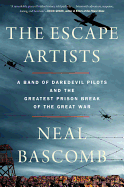
The image of downed English airmen digging out of POW camps and running for the border is associated primarily with World War II, yet that was not the first conflict to find surrendered British soldiers held in the Reich. Just a generation prior, British and French pilots--with more primitive planes, though no less daring--were long-term guests of the Kaiser. These World War I POWs felt the same compulsion to escape as their later cohort. The Escape Artists by Neal Bascomb (The Nazi Hunters, The Perfect Mile) chronicles a group of British plotters who pulled off the largest prison break of the entire war.
The German prison system during World War I took rank into heavy account. Under the newly devised international rules of war, regular privates were allowed to be used as forced labor while officers were not supposed to work. This meant that escapees were almost always officers, since they usually faced solitary confinement upon recapture, whereas orderlies (low-ranking men charged with an officer's housekeeping duties) might be sent to a coal or salt mine.
Despite improved circumstances, officers still faced privations. The Holzminden camp, run by an arbitrary and cruel man named Karl Niemeyer, was sometimes called the worst camp in Germany. In The Escape Artists, Bascomb chronicles the circuitous, often perilous routes several British officers took to their incarceration at Holzminden. Many of these men had already failed several escape attempts. Over a hundred miles from the Dutch border, in a camp designed to hold problematic prisoners, these officers still managed to stage a daring break. Some of them even made it to neutral Holland. The Escape Artists is history at its most thrilling. --Tobias Mutter, freelance reviewer

